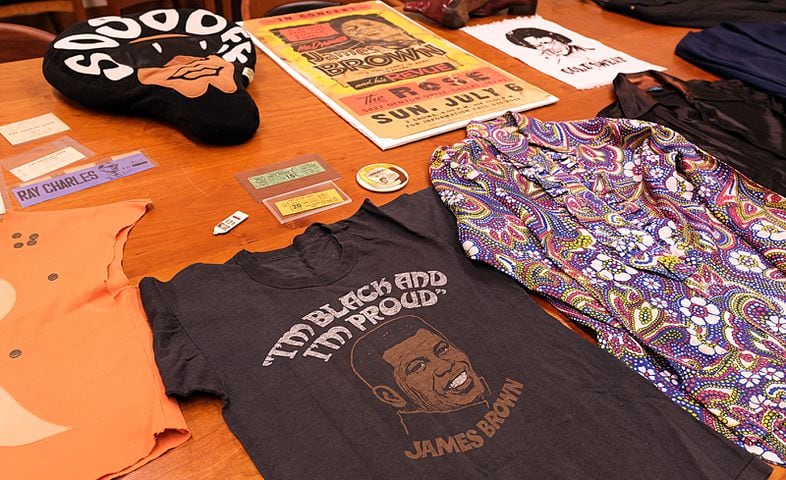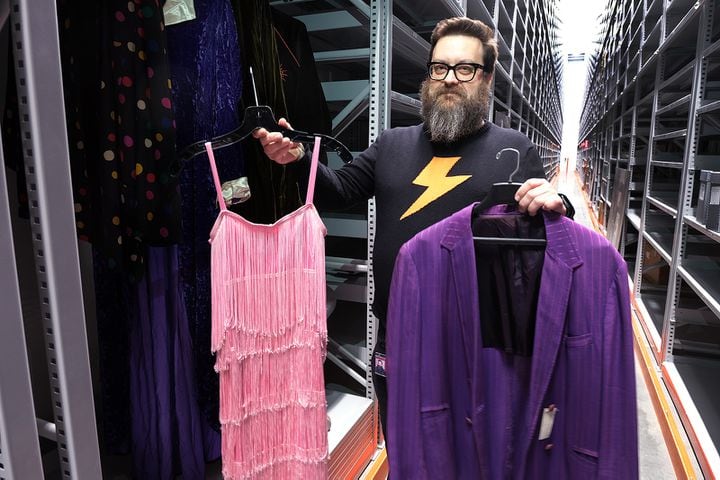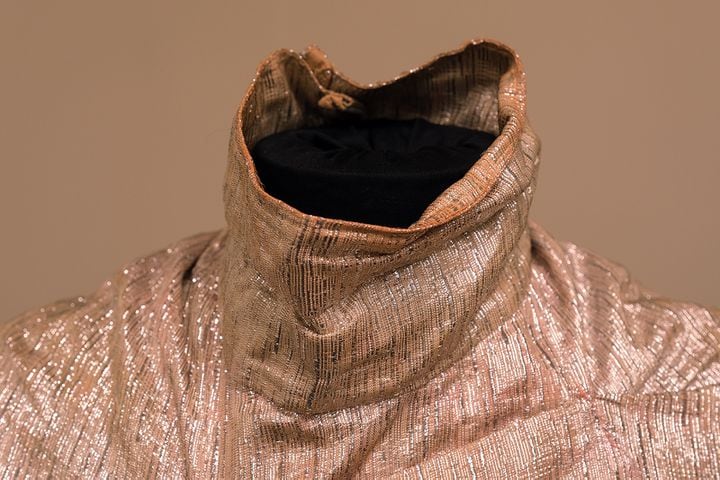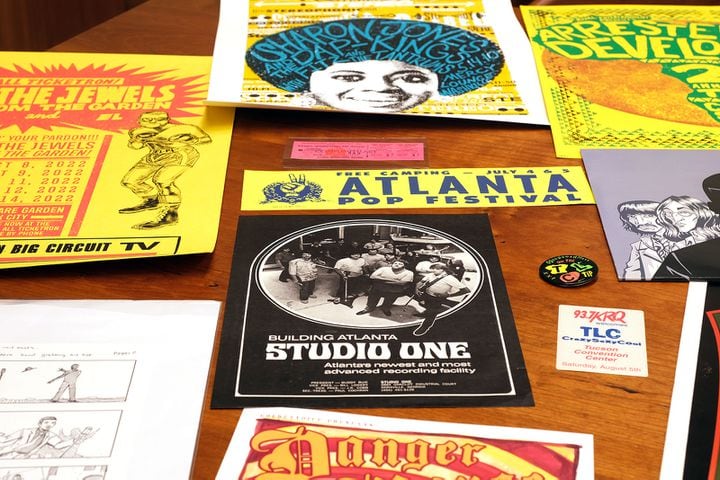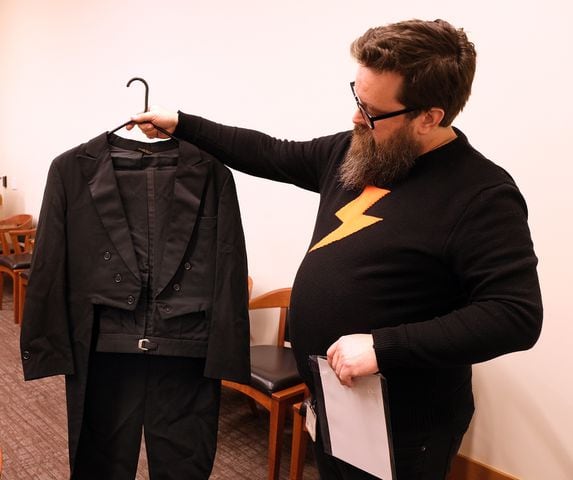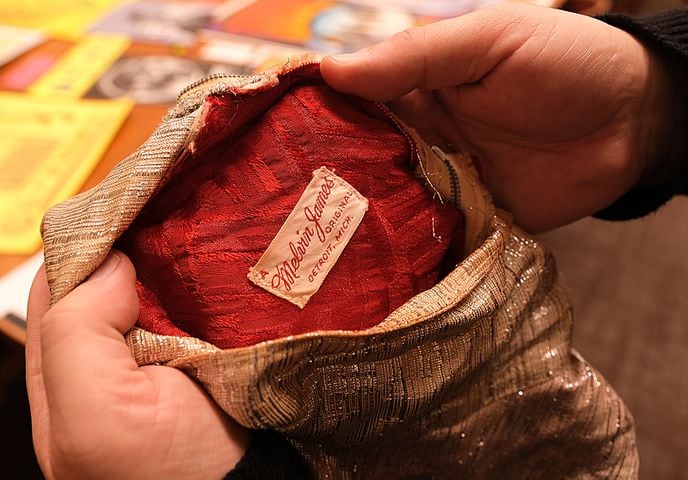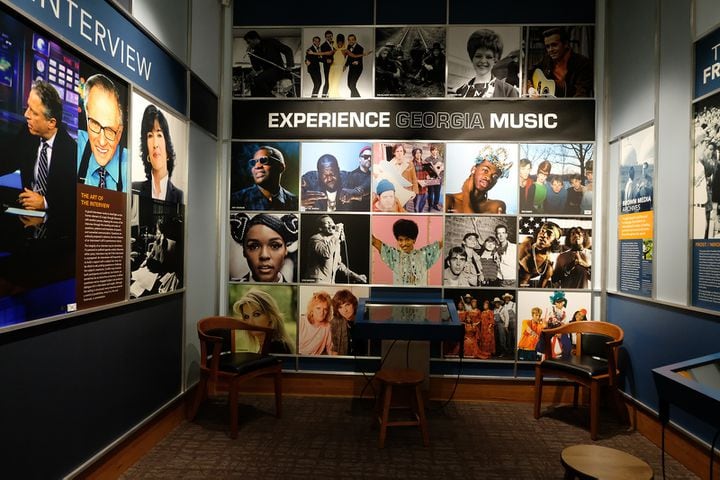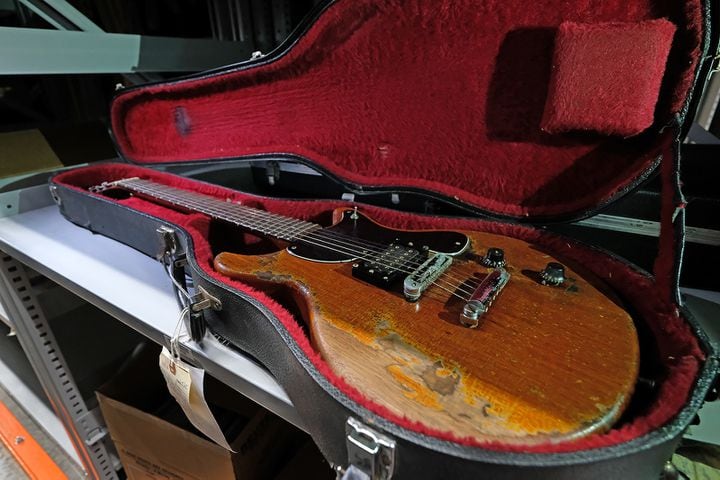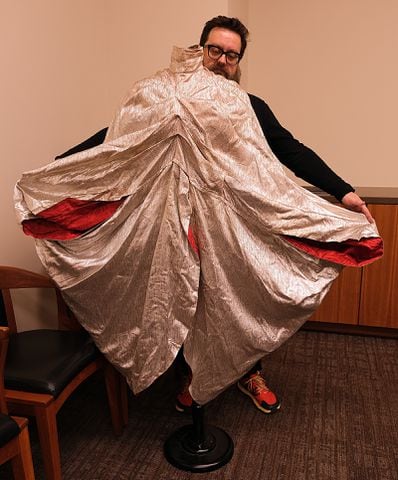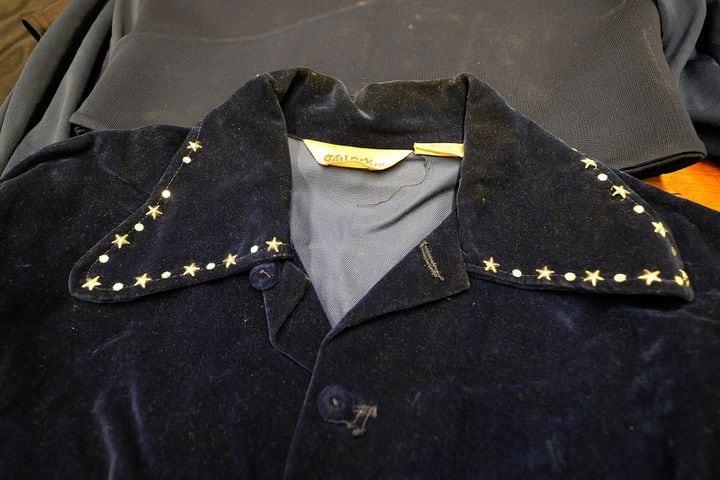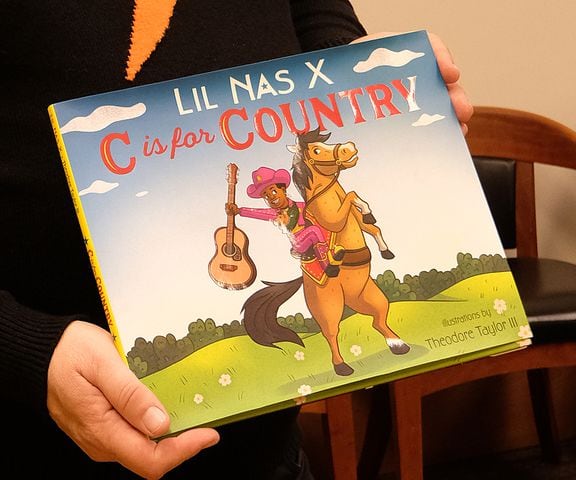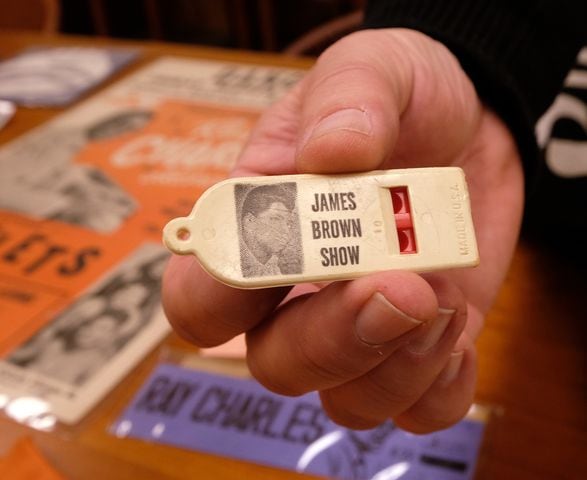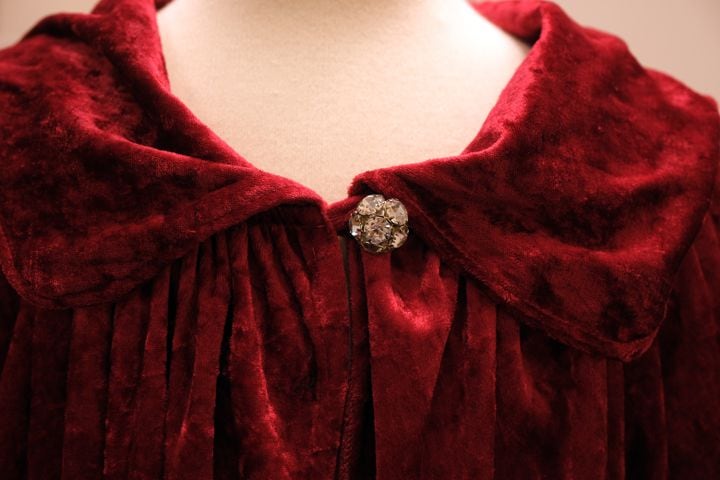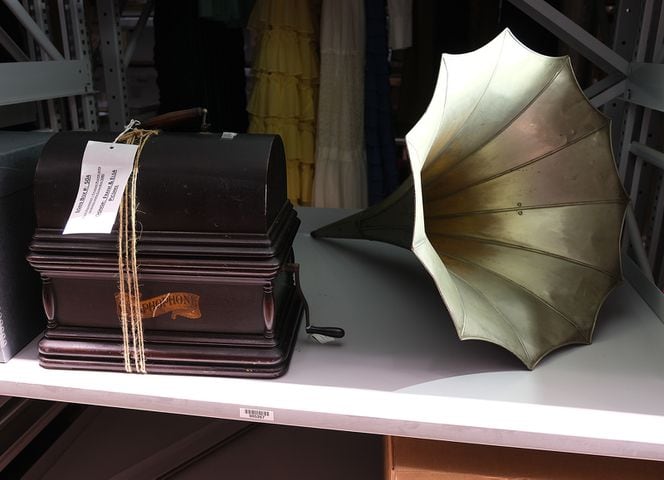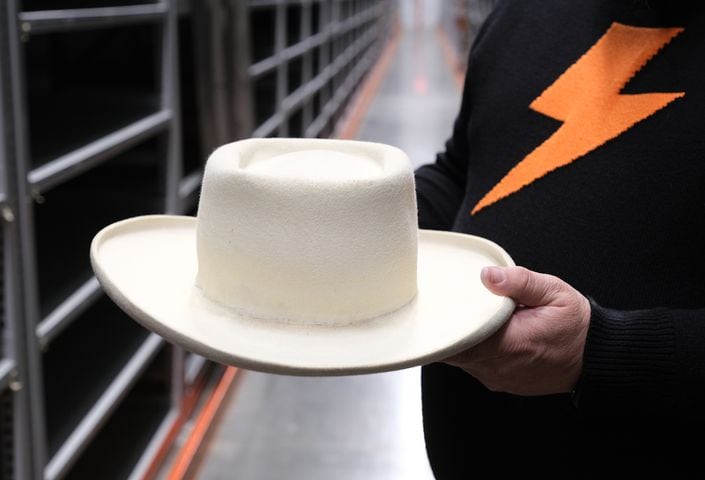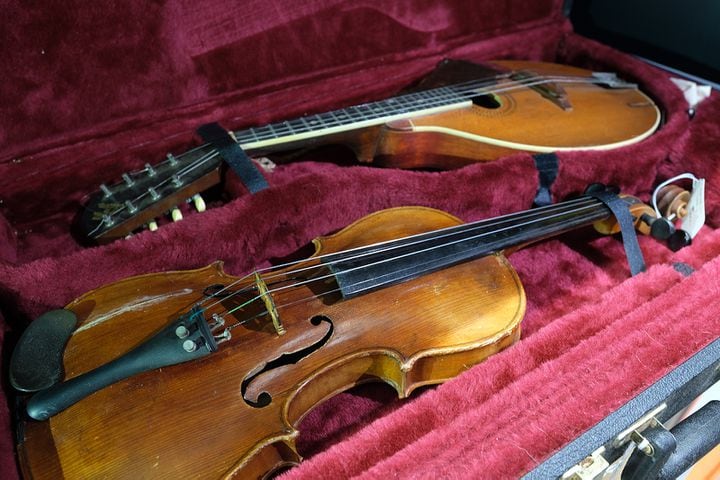ATHENS — An elevator drops 30 feet underground to a locked vault that holds thousands of boxes.
Inside the boxes are boots once worn by James Brown. Wigs that belonged to Cindy Wilson and Kate Pierson of the B-52s. A guitar autographed by R.E.M. and one played by Chet Atkins. Drums from Widespread Panic and Collective Soul. A keyboard from the Atlanta Rhythm Section.
There is also a rare copy of an Otis Redding single with cover art that nearly derailed his career. Photographs of Jimmy Carter and Andy Warhol with the Allman Brothers in woods near Macon. A Ludacris concert set list. A Patti Labelle and Chaka Khan concert ticket at the Fox Theatre. And many, many more things.
Much of Georgia’s rich music history was on display at the sprawling Georgia Music Hall of Fame in Macon until the museum closed its doors in 2011.
Since then, the state’s most diverse historical music collection has sat here, in the basement of the University of Georgia Special Collections Libraries, mostly in boxes and hidden from public view.
But soon the collection could resurface — or at least some of it.
As part of the expansion of the Classic Center, a performance venue in downtown Athens that is more than tripling its concert seating to 6,500, space is being set aside to display a portion of the buried items hopefully before the end of the year.
Credit: Nell Carroll
Credit: Nell Carroll
The critical task of picking out what to highlight has fallen to Ryan Lewis, who co-founded a local record label in the 1990s and later a vinyl record manufacturing facility before being hired last year as the UGA library’s music curator.
Lewis is still getting his arms around what’s inside each of those boxes. During a recent tour with an Atlanta Journal-Constitution reporter he pointed out a Gibson Les Paul Junior guitar played by Don Barnes of 38 Special sitting next to a box full of handmade clothes worn by Hiawassee Cloggers at the Georgia Mountain Fair in 1976.
“It’s just wild stuff, and it’s sort of endless,” Lewis said. “I wonder how many other things that we don’t know about are hiding here.”
Rise and fall of Georgia Music Hall of Fame in Macon
Georgia has no shortage of hall of fame buildings and museums. There are public viewing spaces maintained for college football and military veterans in Atlanta, sports in Macon, motorsports in Dawsonville, aviation in Warner Robins and agriculture, writers and newspapers on UGA’s campus.
The Georgia Music Hall of Fame in Macon was the state’s official music museum when it opened in 1996, boasting a 31,000-piece collection and files on over 1,100 artists in the 48,000 square-foot facility.
With then-Governor Zell Miller leading efforts, the city of Macon donated property and the state legislature allocated millions of dollars. The opening ceremony was attended by Little Richard, Mike Mills and Bill Berry of R.E.M., Travis Tritt, members of The Pips and others. At one time, nearly 50,000 children visited annually with school groups, clubs and other organizations.
“One of the best things about it was the diversity of influences and material,” Mills said.
But waning attendance led to financial difficulties. In 2010, with the Great Recession triggering government cost-cutting, the legislature voted to stop funding.
The day before doors closed in Macon in June 2011, Jessica Walden entered a chapel erected in the main exhibit hall. She sat and watched a video about gospel music.
“That was my chance to say goodbye,” said Walden, the Macon Chamber of Commerce president who previously worked at the Hall of Fame. “In the end, it was packed up, returned to sender or put in archives.”
Many items ended up in Athens, soon after UGA completed construction on the $46 million special collections library building and vault in late 2011.
It’s all part of a much-bigger collection of historical artifacts in the 30,000 square-foot UGA vault, which has a constant 50-degree temperature and 30% humidity to keep the past alive as long as possible. There are at least six million items in all, including 2,500-year-old Babylonian clay tablets, a Ty Cobb baseball card from 1910, and diaries and letters written by Civil War soldiers.
Credit: Nell Carroll
Credit: Nell Carroll
Many other items from the music hall of fame scattered elsewhere. Much of it was returned to musicians and their estates. Some was sent to libraries at Georgia State University and the University of West Georgia.
Walden’s father and uncle in 1969 co-founded the Macon label Capricorn Records credited with launching the Southern rock genre. The day after the hall of fame closed, she started a Macon music tour company.
Macon also boasts The Allman Brothers Band Museum at The Big House, the Otis Redding Museum, the Little Richard House and the Capricorn Sound Studios and Museum. Little Richard’s childhood home in Macon was on the verge of being demolished to make way for interstate expansion before the building was moved.
“Our slogan for this year is, ‘year five and still alive,’” said Robert Banks, an administrator at Little Richard House since it opened in 2019. “That’s because a lot of places like this have closed due to lack of funding. But we’re still here and getting the public involved.”
There is also the Ma Rainey and Blues Museum in Columbus, the Trap Music Museum in Atlanta and James Brown and Brenda Lee artifacts at the Augusta Museum of History.
“I got everything I could put my hands on that had anything to do with this region of the state because they were going to go to UGA and put in a box,” said Nancy Glaser, Augusta Museum of History’s executive director. “I said, ‘Nah, I’d like to put them out on display.’”
Bringing music history out of the boxes
Lewis, who is curating the music items in the UGA basement vault, isn’t your typical librarian.
“People ask me all the time, ‘Did you go to library school or museum school?’” the 48-year-old says. “No, I just made weird and bad choices for 30 years and now I’m an expert on this stuff.”
As Lewis began working his way through the boxes, he realized he didn’t have everything he needed to create an exhibit.
There was an Allman Brothers concert rider detailing which direction the stage must face for outdoor shows to ensure the sun would not set in front of the band. But there were no instruments that Duane or Gregg Allman played.
Brown was known for his fashion style, so much so that he was dressed in three different fits for memorial services after he died in 2006. Lewis had nothing to display on that front, or anything from Little Richard and Lil Nas X’s wardrobe.
“You don’t fill a museum with pieces of paper, right? People want to see clothes and instruments,” Lewis says.
Lewis has been doing what collectors do these days — searching eBay and other online auction sites.
Credit: Nell Carroll
Credit: Nell Carroll
With a $25,000 grant through the Chattanooga based Songbirds Foundation, Lewis bought a cape and boots, with a circular pattern worn in the soles from dancing moves, previously owned by Brown. There’s what Lewis describes as a “silver sparkly cape thing made for sitting at a piano” worn by Little Richard that still has makeup stains. Lewis also found a replica of one of Atlanta rapper Lil Nas X’s outfits created by the Nickelodeon teen comedy show All That.
At or near the top of the wish list still is a guitar played by Duane Allman. That’s not an easy find, due to the rock and blues legend’s death following a motorcycle accident in 1971 at the age of 24.
Money is already in place for the museum display in the expanding Athens concert hall, after the Classic Center Cultural Foundation secured a $100,000 grant.
Construction on the entire project, started in spring of 2022, is behind schedule though — it was supposed to be ready late last year, not late this year. That means the collection won’t be on display when Bob Dylan performs at the Classic Center in March.
The exhibit space also will be much smaller than Macon’s defunct Georgia Hall of Fame. Lewis anticipates having six exhibit display cases, each 10 feet and three feet deep.
But it’s still something.
In the meantime, Lewis continues to dig through the boxes and find new stuff.
While reading descriptions of albums, he noticed Redding’s “Shout Bamalama” from 1961 was included on the list of items shipped from Macon but wasn’t in the proper box. After months of looking, Lewis found it resting behind an Oak Ridge Boys gospel record.
Redding recorded the record on UGA’s campus during the middle of the night for a record label named Confederate. Because of the label’s name, and the Confederate flag on promotional materials, Black DJs refused to play it and it never took off on radio.
Redding later re-released the album on the newly created Orbit label and soon became a star. Redding’s catalog is small because he died when he was only 26. The Confederate release could be considered “the holy grail for a soul music collector,” says Nate Mitchell, the store manager at Wuxtry Records in Athens.

